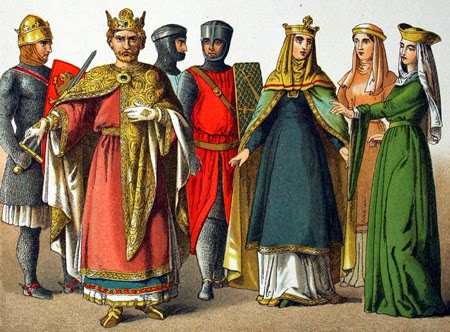 |
| Anglo-Norman Culture |
The Anglo-Norman culture resulted from the fusion of the culture brought over with William the Conqueror when he killed the last English king of England, Harold Godwineson, at the Battle of Hastings in October 1066, with the culture that existed in England. In the 11th and 12th centuries the Normans not only conquered England but also established a kingdom in Sicily.
English culture had developed relatively independent of continental Europe since the time of the coming of the Angles and Saxons in the fifth century, who in turn had been influenced by the native British culture. British culture was a mixture of the Roman culture, which had come with the Roman conquest under Emperor Claudius (41–54), with that of the original Celtic inhabitants.
The English culture at the time of the Norman Conquest of 1066 was dominated by the warrior ethos that the Angles and Saxons had brought with them from mainly what is now Germany. Classics of this period were the poem of “The Battle of Maldon,” as well as the better-known saga of Beowulf.
  |
Heaney describes this militaristic society when he writes of how “the ‘Finnsburg episode’ envelops us in a society that is at once honor-bound and blood-stained, presided over by the laws of the blood-feud ... the import of the Finnsburg passage is central to the historical and imaginative world of the poem as a whole.” The Anglo-Saxon tongue began to lose out to the Norman French, which also included the influence of Scandinavia, where the Normans had originally come from before settling in France in the 10th century.
It was the rising Anglo-Norman culture that created a hero out of King Arthur. Based on earlier writings, authors like Geoffrey of Monmouth wrote History of the Kings of Britain between 1136 and 1138. Arthur was a native British chieftain who fought the Angles and Saxons, thus giving them little cause to celebrate him. But in seeking to give legitimacy to the Norman kings, writers like Geoffrey sought to trace the monarchy back to its earliest days and thus found inspiration in the earlier accounts of Arthur.
According to Helen Hill Miller in The Realms of Arthur, “the Anglo-Norman kings ... needed an independent source for their British sovereignty: as dukes of Normandy they were subject to the heirs of Charlemagne,” the kings of France. Geoffrey used accounts written by the monks Nennius in the ninth century and Gildas, who may have lived in the time of the historical Arthur, in the sixth and seventh centuries.
According to Helen Hill Miller in The Realms of Arthur, “by January 1139, a copy from his rather heavy Latin into Anglo-Norman verse was promptly undertaken at the request of the wife of an Anglo-Norman baron in Lincolnshire. By 1155, a further translation, likewise in verse, had been completed by Maistre de Wace of Caen, a Jerseyman who spent most of his life in France.”
 |
| Anglo-Norman dresses |
Geoffrey wrote during the reign of Henry I (1100–35), perhaps the first Norman king to see himself as English first and Norman secondarily. Writing at the same time on Arthurian topics were Walter Map and Maistre [Master] Wace, who wrote the Roman de Brut and Roman de Rou.
Other writers applied themselves to building up the Anglo-Norman civilization. William of Malmesbury wrote Acts of the English Kings and On the Antiquity of the Church of Glastonbury. William, like Geoffrey, consciously fused the Normans with the Celtic past, because Glastonbury was the holiest site in Celtic Britain.
Tradition had it that Joseph of Arimathea, he who had given his tomb for Christ to be buried in after the Crucifixion, founded a small church at Glastonbury. The pious at the time also believed that Joseph, who traditionally in England had been seen as a merchant for English tin, had even brought the young Jesus (Christ) of Nazareth to visit Glastonbury.
   |
The church served as another institution in building a rising new culture in England, as memories of the conquest of 1066 dimmed with the passage of time. Symbolic of this was the actual building of churches in the Romanesque architecture, which the Normans had mainly brought with them from France.
The institution of the church was put to use by Henry I. The Cistercian order of monks arrived in England in 1128 and began development of advanced agriculture and sheep raising. In order to cement the church as an instrument of royal development, the king named the great prelates who ruled the church, to assure their support for his reign. William began this policy after the conquest.
Along with the great bishoprics like York and Canterbury, monastic orders also flourished under Anglo-Norman rule and would be a central part of both English culture and economy until the monastic system was destroyed during the reign of Henry VIII (1509–47).
Using Normandy as a model, Henry I and the kings who followed him freely granted charters to towns, enabling the establishment of a town life that would be one of the hallmarks of England during the Middle Ages. London, where William built his White Tower, gained the ascendancy in England in commercial life that it still enjoys today. Towns, the estates of the great feudal lords, and the church establishments were the pillars that formed the foundation of the Anglo-Norman culture that arose after the conquest of 1066.
Feudalism, the system of lords holding their lands at the will of the king, really came to England with William, who granted land holdings to those Breton, French, and Norman warriors who had come with him to fight the Saxon King Harold in October 1066. By the end of Henry I’s reign in 1135, only some 70 years after the conquest, the fusion between the old and the new was complete, and the Anglo-Norman culture flourished in England.